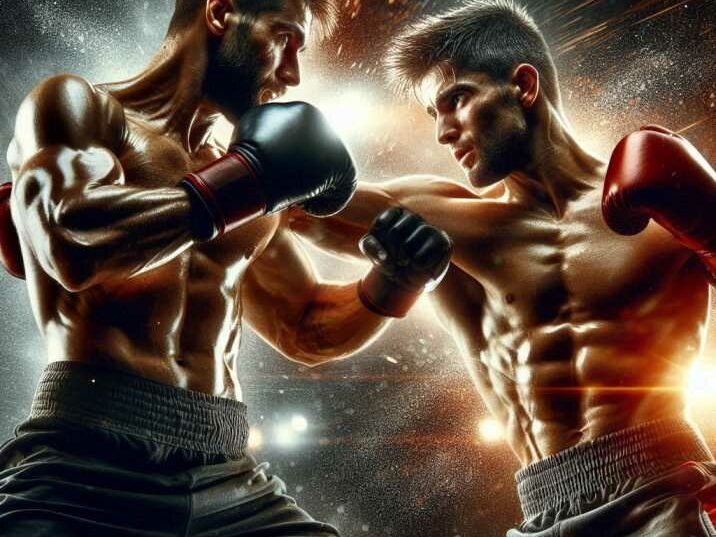Introduction:
Table of Contents
Kickboxing and Muay Thai are two popular martial arts that have captivated enthusiasts around the world. In this article, we will explore the origins, techniques, and unique aspects of these combat sports. Whether you’re a fan of martial arts, an aspiring fighter, or simply curious about these disciplines, this guide will provide you with a comprehensive overview about Kickboxing vs. Muay Thai.

1. What is Kickboxing?
Kickboxing is a dynamic combat sport that combines elements of boxing and martial arts. It originated in the United States in the 1960s and gained popularity worldwide. Kickboxing involves striking techniques using both hands and feet, making it a versatile and exciting martial art.
1.1 History
The history of kickboxing can be traced back to various martial arts traditions from around the world. It was influenced by Japanese karate, Muay Thai from Thailand, and Western boxing. Kickboxing emerged as a sport in the 1960s when practitioners from different disciplines began competing against each other.
1.2 Techniques
Kickboxing incorporates a wide range of techniques, including punches, kicks, knee strikes, and elbow strikes. The primary focus is on striking, with practitioners using their fists, feet, and knees to deliver powerful blows to their opponents. The techniques are executed with precision, speed, and agility, requiring a combination of strength and skill.
1.3 Famous Kickboxers
Kickboxing has produced many legendary fighters who have made a significant impact on the sport. Some of the famous kickboxers include:
- Ramon Dekkers: A Dutch kickboxer known for his aggressive fighting style and powerful punches. He won multiple world titles and is considered one of the greatest kickboxers of all time.
- Peter Aerts: A Dutch kickboxer who dominated the heavyweight division in the 1990s. He was a three-time K-1 World Grand Prix champion and known for his powerful kicks.
- Buakaw Banchamek: A Thai kickboxer who gained international recognition for his exceptional skills and entertaining fighting style. He has won numerous championships and is admired for his lightning-fast kicks.
2. What is Muay Thai?
Muay Thai, also known as Thai Boxing, is the national sport of Thailand. It is a stand-up striking sport that involves two competitors in the ring throwing punches, elbows, knees, and kicks at each other. Muay Thai is renowned for its effectiveness in both self-defense and competitive fighting.
2.1 History
Muay Thai has a rich history that dates back several centuries. It originated as a form of close-combat fighting used by the Siamese military. Over time, it evolved into a popular sport and cultural tradition in Thailand. Muay Thai gained international recognition in the 20th century and has since become a global phenomenon.
2.2 Techniques
Muay Thai techniques encompass a wide range of strikes, including punches, kicks, knee strikes, and elbow strikes. It also involves the use of clinching techniques, which allow fighters to control their opponents in close quarters. Muay Thai fighters undergo rigorous training, focusing on conditioning, technique, and strategy.
2.3 Famous Muay Thai Fighters
Muay Thai has produced numerous legendary fighters who have left a lasting impact on the sport. Some of the famous Muay Thai fighters include:
- Samart Payakaroon: Widely regarded as one of the greatest Muay Thai fighters of all time, Samart was known for his exceptional skills and versatility. He won multiple championships in different weight classes.
- Saenchai: Considered one of the most skilled Muay Thai fighters, Saenchai is known for his agility, technique, and unorthodox fighting style. He has won numerous titles and is admired for his creativity in the ring.
- Yodsanklai Fairtex: A dominant force in the Muay Thai world, Yodsanklai is known for his devastating kicks and powerful strikes. He has achieved great success in both Thailand and international competitions.
Remember, kickboxing and Muay Thai have their own unique characteristics, techniques, and histories. While they share similarities as striking-based martial arts, they also have distinct rules and training methods. Both disciplines offer exciting opportunities for physical fitness, self-defense, and personal growth.
3. Differences Between Kickboxing vs. Muay Thai
3.1 Rules and Regulations
The rules and regulations of kickboxing vs. Muay Thai differ in several aspects. Kickboxing, particularly the K-1 style, follows a rule set that allows punches, kicks, and knees. Clinching is limited to a few seconds, and the fighter must be actively kneeing inside the clinch. Kickboxing matches typically consist of three rounds, although championship fights may have five rounds.On the other hand, Muay Thai matches are generally five rounds long. Clinching is a significant aspect of Muay Thai, and fighters can engage in clinching for longer periods. Strikes, sweeps, and throws executed from the clinch are highly scored in Muay Thai. Elbows and knees are also allowed in Muay Thai, making it a more versatile striking art compared to kickboxing
3.2 Training Methods in kickboxing vs. Muay Thai
The training methods in kickboxing vs. Muay Thai also have some differences. Kickboxing training often focuses on footwork and punches, with an emphasis on boxing techniques. Kickboxers are known for their volume striking, combining boxing combos with low and high kicks. Training sessions typically include shadow boxing, heavy bag work, pad work, strength training, and conditioning.
In Muay Thai training, fighters undergo rigorous conditioning and technique development. Training sessions include multiple rounds of shadow boxing, heavy bag work, pad work, and clinch training. A cornerstone of Muay Thai conditioning is Thai pad training, where fighters practice punches, kicks, knees, and elbow strikes with a trainer wearing thick pads. This allows fighters to develop power, accuracy, and timing in their strikes
3.3 Striking Techniques
The striking techniques in kickboxing vs. Muay Thai also differ in certain aspects. Kickboxing is built on a four-point striking system, consisting of two punches and two kicks. Kickboxers often fight from a distance, utilizing their punches and kicks to maintain range. Footwork and combinations play a crucial role in kickboxing.In contrast, Muay Thai employs an eight-point striking system. In addition to punches and kicks, Muay Thai incorporates knee strikes, elbow strikes, and upper-body grappling known as the full clinch.
Muay Thai fighters are known for their ability to move in and out of their opponent’s pocket, utilizing a wider range of striking techniques. The clinch is a significant aspect of Muay Thai, allowing fighters to control their opponents and execute devastating strikes
4. Similarities Between Kickboxing vs. Muay Thai
4.1 Focus on Striking
Both kickboxing and Muay Thai share a common focus on striking techniques. Punches, kicks, and knee strikes are fundamental elements in both martial arts. The emphasis on striking allows practitioners to develop power, speed, and accuracy in their attacks. Whether it’s delivering a powerful punch or executing a precise kick, both kickboxing and Muay Thai provide a platform for practitioners to hone their striking skills.
4.2 Physical and Mental Benefits
Engaging in kickboxing vs. Muay Thai training offers numerous physical and mental benefits. Both martial arts provide an intense cardiovascular workout, improving overall fitness, stamina, and strength. The training also enhances coordination, agility, and flexibility. Moreover, kickboxing and Muay Thai training promote discipline, focus, and self-confidence. The mental aspects of these martial arts help practitioners develop resilience, determination, and a strong mindset.
4.3 Global Popularity
Kickboxing and Muay Thai have gained significant popularity worldwide. Both martial arts have attracted a large following of practitioners, enthusiasts, and spectators. Kickboxing promotions like K-1 and Glory have showcased high-level competitions, while Muay Thai events such as Lumpinee Stadium and Rajadamnern Stadium in Thailand have become iconic venues for the sport. The global appeal of kickboxing and Muay Thai continues to grow, with fighters from various countries competing at the highest levels.
Table of Information comparing kickboxing vs. Muay Thai:
| Aspect | Kickboxing | Muay Thai |
|---|---|---|
| Rules and Regulations | Punches, kicks, and knees allowed with limited clinching | Punches, kicks, knees, and elbows allowed with extended clinching |
| Training Methods | Focus on footwork, punches, and kicks | Emphasis on clinching, punches, kicks, knees, and elbows |
| Striking Techniques | Four-point striking system (punches and kicks) | Eight-point striking system (punches, kicks, knees, elbows) |
| Focus on Striking | Both kickboxing and Muay Thai emphasize striking techniques | Both kickboxing and Muay Thai focus on striking as the primary form of attack |
| Physical and Mental Benefits | Both offer cardiovascular workout, improved fitness, coordination, and self-confidence | Both provide physical and mental benefits, enhancing overall well-being |
| Global Popularity | Kickboxing and Muay Thai have gained significant popularity worldwide | Both martial arts have a global following and fan base |
5. Conclusion:
Kickboxing vs. Muay Thai represent the perfect blend of power, precision, and discipline. These martial arts have gained immense popularity across the globe due to their dynamic techniques and physical benefits. Whether you’re looking to improve your fitness, learn self-defense, or compete at a professional level, kickboxing and Muay Thai offer a path to personal growth and empowerment. Embrace the art of combat sports and unleash your potential.
5. Frequently Asked Questions (FAQs)
5.1 What is the difference between kickboxing and Muay Thai?
The main differences between kickboxing and Muay Thai lie in the rules and techniques. Kickboxing typically involves punches, kicks, and knees, with limited clinching. Muay Thai allows a wider range of strikes, including elbows and knees, and places a greater emphasis on clinching and sweeps.
5.2 Can anyone practice kickboxing or Muay Thai?
Yes, anyone can practice kickboxing or Muay Thai. Both martial arts cater to individuals of different ages, genders, and fitness levels. Whether you’re a beginner or an experienced athlete, kickboxing and Muay Thai offer training programs suitable for all.
5.3 Are kickboxing and Muay Thai considered dangerous sports?
Like any contact sport, there are inherent risks involved in kickboxing and Muay Thai. However, with proper training, supervision, and adherence to safety protocols, the risks can be minimized. It is essential to train under the guidance of qualified instructors and use appropriate protective gear to ensure safety.
5.4 How long does it take to become proficient in kickboxing or Muay Thai?
The time it takes to become proficient in kickboxing or Muay Thai varies depending on individual dedication, training frequency, and natural aptitude. With consistent training and practice, one can expect to see progress within a few months. However, mastery of these martial arts requires years of dedicated training and continuous learning.
5.5 Are there any female kickboxing or Muay Thai champions?
Yes, there are numerous female kickboxing and Muay Thai champions who have achieved great success in their respective disciplines. Female fighters have made significant contributions to the sport and have become role models for aspiring practitioners.


